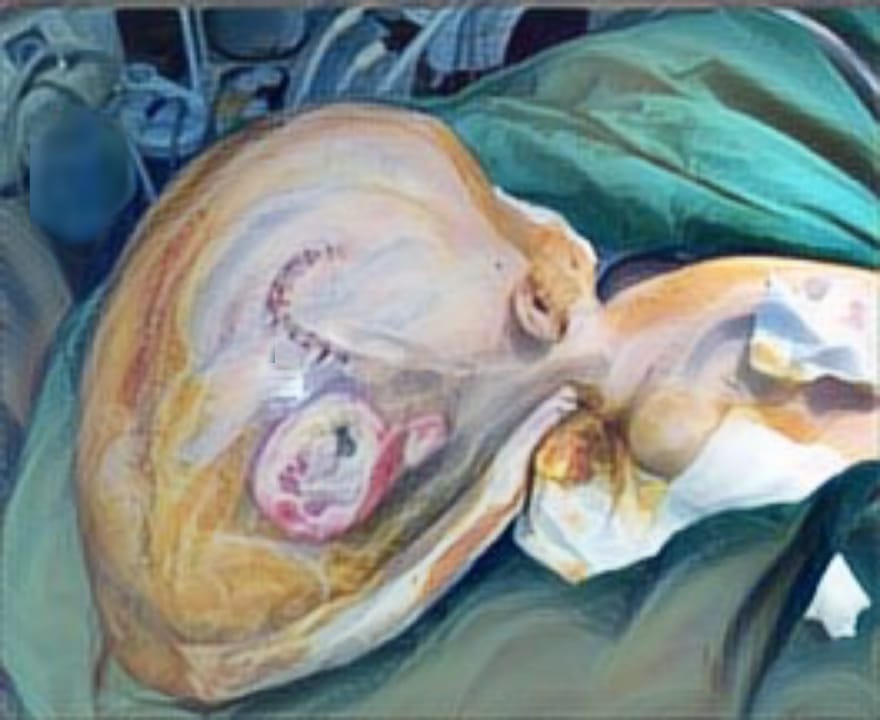A CASE REPORT: EARLOBE RECONSTRUCTION ON CONGENITAL AURICULAR LOBE DEFECT USING Z-PLASTY

Downloads
Highlights:
- Congenital ear defects typically result from growth failures during the fifth to ninth weeks of gestation or from mechanical stress during this period.
- Auricular lobuloplasty using the Z-plasty flap technique effectively addresses earlobe defects, resulting in optimal aesthetic outcomes with no keloid formation, minimal scarring, and no complications.
Abstract:
Introduction: Earlobe defects, often due to embryonal growth failure or injury, can affect aesthetics and social interactions despite not impacting hearing. Earlobe defect can be formed either from birth as congenital defect or secondary manifestation of other causes such as tumor and external factor such as earring usage or trauma. This study aimed to address these issues by performing auricular lobuloplasty using a Z-plasty flap technique. The procedure, crucial for protecting the auditory canal and facilitating eyeglass use, was successful in achieving the desired aesthetic outcome. Data on microtia prevalence, particularly in Indonesia, highlights the need for such reconstructive surgeries.
Case Illustration: A 9-year-old boy underwent auricular lobuloplasty to correct a cleft earlobe deformity, which caused social discomfort. The surgery, performed under general anesthesia, utilized a Z-plasty technique to lengthen and reorient the scar. Postoperative care included wound dressing changes and oral pain medication. After two weeks, satisfactory results were observed with no reported complications.
Discussion: The study on congenital ear deformities focuses on Z-plasty for earlobe reconstruction, detailing classifications, surgical techniques, and case results. The surgery was successful with minimal scarring and no keloid formation. Using Weerda's classification, the technique showed minimal scarring and no keloid formation. The approach, emphasizing proper skin envelope and alignment with Langer lines, offers effective aesthetic restoration, making it a valuable reference for future earlobe reconstruction cases.
Conclusion: Utilizing Z-plasty for earlobe defect reconstruction aids in improving the earlobe's appearance with minimal to no complications.
Norris II and Cook J. The Cheek Interpolation Flap for Reconstruction of Auricular Mohs Defects. Dermatol Surgery. 2020.46(8): 1039–1044. DOI:10.1097/DSS.000000000 0002226
Veugen CCAFM, Dikkers FG, and de Bakker BS. The Developmental Origin of the Auricula Revisited. Laryngoscope. 2020. 130 (10):2467-2474. DOI:10.10 02/lary.28 456
Van Nunen DPF, Kolodzynski MN, Van den Boogaard MJH, Kon M, and Breugem CC. Microtia in the Netherlands: clinical characteristics and associated anomalies. International Journal of Pediatric Otorhinolary ngology. 2014. 78(6): 954-959. DOI:10.1016/j.ijporl.2014.03.024
Luquetti DV, Heike CL, Hing AV, Cunningham ML and Cox TC. Microtia: epidemiology and genetics. American Journal of Medical Genetics Part A. 2012. 158(1):124-139. DOI:10.1002/ajmg.a. 343 52
The Aesthetic Society. Aesthetic Plastic Surgery National Databank. 2022.
Kartanegara FMS and Boesoerie SF.Characteristics of Microtia Patients at Dr. Hasan Sadikin Bandung General Hospital Period 2017–2022. In Proceedings of the 19th Otorhinolaryngology Head and Neck Surgery National Congress (PERHATIKL 2022). Springer Nature; 2023. 68. p.55-58.
Putri IL, Dwika Intania Riano, Lavonia Berlina Adzalika, and Pramanasari R. THE EPIDEMIOLOGY OF PLASTIC SURGERY CASES IN A TERTIARY GENERAL HOSPITAL IN SURABAYA, INDONESIA. Jurnal Rekonstruksi dan Estetik 2023; 8: 21–28. DOI: 10.20 473/jre.v8i1.45272
Siegert R and Magritz R. Otoplasty and Auricular Reconstruction. Facial Plastic Surgery.2019. 35(04):377-386. DOI: 10.10 55/s-0039-1693745
Ebrahimi A, Kazemi A, Rasouli HR, Kazemi M, and Motamedi MHK. Reconstructive Surgery of Auricular Defects: An Overview. Trauma monthly. 2015. 20(4): 28202. DOI: 10.5812/traumamon.28202
Zito PM, Jawad BA, Hohman MH, and Mazzoni T. Z-Plasty. Local Flaps in Facial Reconstruction 2023; 313–336. PMID: 299 39552
Liaw J, Patel VA, and Carr MM. Congenital anomalies of the external ear. Operative Techniques in Otolaryngology-Head and Neck Surgery. 2017. 28(2):72-76. DOI:10.1016/j.otot. 2017.03.012
Bartel-Friedrich S, and Wulke C. Classification and diagnosis of ear malformations. GMS current topics in otorhinolaryngology, head and neck surgery, 2007.6.Doc05. Epub 2008 Mar 14. PMID: 22073081; PMCID: PMC3199848.
Weerda H. Chirurgie der Ohrmuschel: Verletzungen, Defekte und Anomalien. 29 Tabellen.Stuttgart: Thieme.Georg Thieme Verlag. 2004:105–226.
Sivam SK, Taylor CB, and Stallworth CL. Reconstruction of upper third auricular defects. Techniques in Otolaryngology-Head and Neck Surgery.2017. 28(2): 105-113. DOI:10.1016/j.otot.2017.03.0 08
Xing W, Kang C, Wang Y, and Zhang Q. Reconstruction of Microtia Using a Single Expanded Postauricular Flap without Skin Grafting: Experience of 683 Cases. Plastic and Reconstructive Surgery. 2018. 142 (1): 170-179. DOI: 10.1097/PRS.00000000000 04493
Tam CK, McGrath CP, Ho SMY, Pow EHN, Luk HWK, and Cheung LK. Psychosocial and quality of life outcomes of prosthetic auricular rehabilitation with CAD/CAM technology. Int J Dent; 2014. Epub ahead of print 2014. DOI: 10.1155/2014/393571.
Sinha A, Baranwal S, Babu VS, and Jha MK. Postauricular Tubed Flap in the Reconstruction of Auricular Margin Defects: Revisited. Indian Journal of Plastic Surgery.2021. 54(02): 197-200. DOI: 10.10 55/s-0041-1729508
Roche AM, Griffin M, Shelton R, and Urken ML. The folded postauricular flap: A novel approach to reconstruction of large full thickness defects of the conchal bowl. American Journal of Otolaryngology. 2017.38(6): 706-709. DOI: 10.1016/j.amjoto .2017. 09.006
Schmidt M, Zaussinger M, Duscher D, and Huemer GM. Preauricular pull through flap for reconstruction of the auricle. Journal of Plastic, Reconstructive & Aesthetic Surgery. 2021.74(1):130-134. DOI: 10.1016/j.bjps. 2020.05.078
Crisan D, Schneider LA, Kastler S, Scharffetter"Kochanek K, Crisan M, and Veit JA. Surgical management of skin cancer and trauma involving the middle third of the auricle. JDDG: Journal der Deutschen Dermatologischen Gesellschaft. 2018. 16(6): 694-701. DOI: 10.1111/ddg. 13544
Antia NH and Buch VI. Chondrocutaneous advancement flap for the marginal defect of the ear. Plastic and reconstructive surgery.1967. 39(5) : 472-477.
Senner S, Eicher L, Nasifoglu S, and Wollenberg A. Linear patterns of the skin and their dermatoses. JDDG: Journal der Deutschen Dermatologischen Gesellschaft. 2020. 18(4):341-364. DOI:10.1111/ddg.14 06 6
Yotsuyanagi T. Earlobe reconstruction using a chondrocutaneous flap. Plastic and reconstructive surgery. 1994. 94(7):1073-1078.
Matsumoto E, Liang H, Mahadevan L. Topology, geometry and mechanics of surgical Z-plasty. Phys Rev Lett; 120. Epub ahead of print 2 May 2019. DOI: 10.110 3/PhysRevLett.120.068101.
Wilhelmi BJ, Blackwell SJ, Mancoll JS, and Phillips LG. Creep vs. stretch: a review of the viscoelastic properties of skin. Annals of plastic surgery.1998. 41(2):215-219.
Charles H. Thorne, Kevin C. Chung, Arun K. Gosain, et al. Grabb and Smith's Plastic Surgery. 2019; 1054.
Copyright (c) 2024 Nida' Fahima Amatullah, Iswinarno Doso Saputro

This work is licensed under a Creative Commons Attribution-ShareAlike 4.0 International License.
JURNAL REKONSTRUKSI DAN ESTETIK by Unair is licensed under a Creative Commons Attribution-ShareAlike 4.0 International License.
- The journal allows the author to hold copyright of the article without restriction
- The journal allows the author(s) to retain publishing rights without restrictions.
- The legal formal aspect of journal publication accessbility refers to Creative Commons Attribution Share-Alike (CC BY-SA)




















